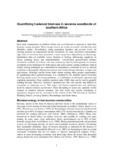Please use this identifier to cite or link to this item:
https://cris.library.msu.ac.zw//handle/11408/1916Full metadata record
| DC Field | Value | Language |
|---|---|---|
| dc.contributor.author | Paradzayi, Charles | - |
| dc.contributor.author | Annegarn, H.J. | - |
| dc.date.accessioned | 2017-03-10T12:27:16Z | - |
| dc.date.available | 2017-03-10T12:27:16Z | - |
| dc.date.issued | 2006 | - |
| dc.identifier.uri | https://2001-2009.state.gov/documents/organization/110869.pdf | - |
| dc.identifier.uri | http://www.aag.org/galleries/gdest/Annegarnpaper.pdf | - |
| dc.identifier.uri | http://hdl.handle.net/11408/1916 | - |
| dc.description.abstract | Most rural communities in southern Africa rely on fuelwood or charcoal to meet their domestic energy demands. These energy sources are readily accessible and often the only affordable means. Nevertheless, rising population densities and poverty levels are exerting pressure on unprotected natural woodlands. In many electrified communities, high costs of electricity have prevented a move away from dependency on bio-energy. Quantitative data on available woody biomass is lacking, influencing negatively on energy planning policy and implementation. Conventional ground-based biomass assessment methods are tedious and time-consuming. Species heterogeneity of savanna woodlands poses challenges for both optical and radar remote sensing platforms. Optical remote sensing techniques are constrained by atmospheric conditions as well as spectral resolution to distinguish different tree species and woody biomass densities in large-scale applications. Although satellite borne radar remote sensing offers greater opportunities for quantifying above-ground biomass, it is inhibited by the medium spatial resolution and long repeat cycles of current platforms. A combination of allometric equations and vegetation parameters from synthetic aperture radar (SAR) data can be used to quantify standing biomass. However, allometric equations are often site specific and difficult to extrapolate to landscape scales. This paper will discuss opportunities and challenges faced by natural resource practitioners when attempting to assess and quantify woody biomass in southern African savannas. The data needs and current availability of appropriate imagery will be presented in the context of the VW Foundation Bio-fuels Modeling Project, covering Zambia, Mozambique and South Africa. | en_US |
| dc.language.iso | en | en_US |
| dc.subject | Fuelwood biomass, Rural domestic energy | en_US |
| dc.title | Quantifying fuelwood biomass in savanna woodlands of southern Africa: Paper presented at Global Dialogue on Emerging Sciences and Technology Conference, Cape Town, March 2008 | en_US |
| dc.type | Presentation | en_US |
| item.openairetype | Presentation | - |
| item.openairecristype | http://purl.org/coar/resource_type/c_18cf | - |
| item.fulltext | With Fulltext | - |
| item.languageiso639-1 | en | - |
| item.grantfulltext | open | - |
| item.cerifentitytype | Publications | - |
| Appears in Collections: | Conference Papers | |
Files in This Item:
| File | Description | Size | Format | |
|---|---|---|---|---|
| Annegarnpaper.pdf | 90.25 kB | Adobe PDF |  View/Open |
Items in MSUIR are protected by copyright, with all rights reserved, unless otherwise indicated.



